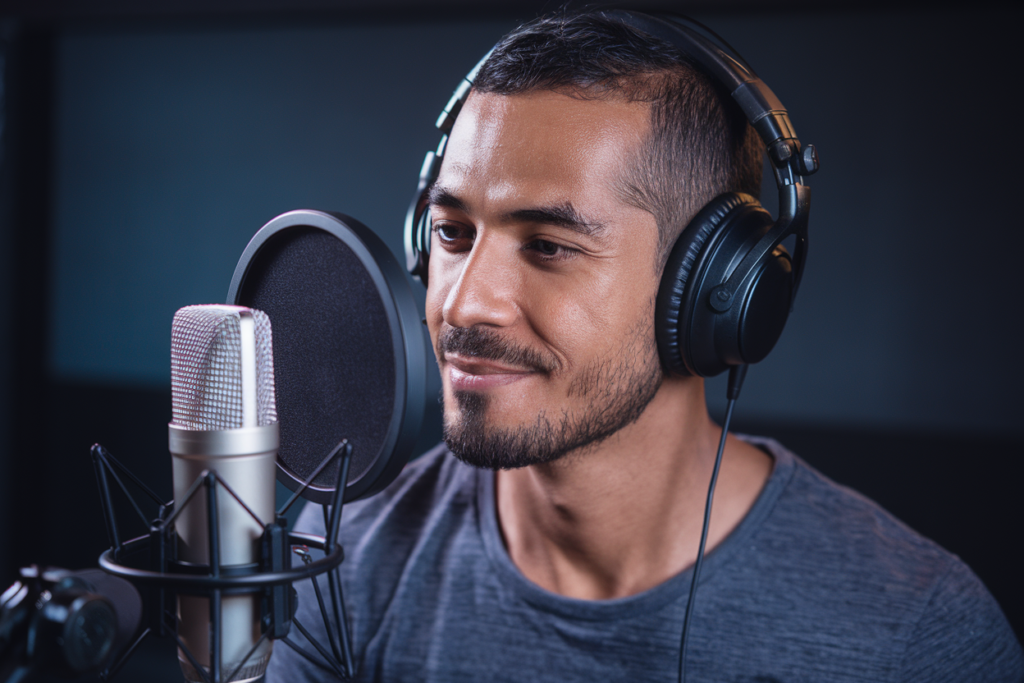Key Takeaways
- Dialectical Diversity: Gulf and Levantine Arabic feature distinct dialects with unique pronunciations, vocabulary, and cultural references that voice actors must master for authentic performances.
- Cultural Relevance: Understanding local customs, social dynamics, and traditions is crucial in creating relatable scripts that resonate with the respective audiences.
- Pronunciation Challenges: Variations in phonetics across regions can lead to misunderstandings; accurate pronunciation is vital for effective communication in voiceover projects.
- Training Importance: Investing in specialized training helps voice actors hone their skills in navigating dialectal nuances and cultural contexts essential for impactful storytelling.
- Technology Utilization: Leveraging recording tools and software aids in producing high-quality audio while ensuring adherence to regional linguistic standards.
- Engagement Strategies: Incorporating relevant cultural elements into scripts enhances audience connection and strengthens the overall message delivery.
Ever wondered why voiceover projects in Gulf and Levantine Arabic can feel like navigating a maze? With rich dialects and cultural nuances, these languages present unique challenges that can trip up even the most seasoned professionals. Whether you’re working on commercials, animations, or audiobooks, understanding these hurdles is crucial for delivering authentic and impactful content.
From pronunciation quirks to regional slang, mastering Gulf and Levantine Arabic requires more than just linguistic skills. It’s about connecting with your audience on a deeper level. So if you’re looking to enhance your voiceover work in these dialects, let’s dive into the common obstacles you might face and how to overcome them effectively.
Overview of Voiceover in Arabic
Voiceover work in Arabic, particularly Gulf and Levantine dialects, presents unique opportunities and challenges. Each region boasts distinct pronunciations, expressions, and cultural references. Understanding these nuances is crucial for any voiceover project.
You might wonder why dialect matters so much. Different Arabic-speaking audiences connect with their local dialects on a personal level. A voice talent skilled in Gulf Arabic may not resonate with an audience familiar with Levantine phrases. That’s where the expertise of a voice artist comes into play.
Voice actors also face obstacles like varying accentuation and rhythm across these regions. For example, while some areas emphasize certain vowels or consonants, others may have completely different inflections. This diversity requires voice over talent to adapt their delivery style accordingly.
Cultural context enriches the narrative too. When crafting scripts for different Arab audiences, it’s essential to incorporate relevant cultural references that engage listeners effectively. A seasoned voice over artist understands this balance well—making sure the content feels authentic rather than forced.
Successful voiceovers in Gulf and Levantine Arabic hinge on understanding dialectical differences, pronunciation variations, and cultural relevance. Engaging a qualified voice over actor can significantly enhance your project’s impact by creating a genuine connection with your target audience.
Understanding Gulf Arabic
Gulf Arabic presents unique characteristics that voice actors must grasp for effective communication. This dialect, spoken across the Arabian Peninsula, varies significantly from other Arabic forms in pronunciation and vocabulary.
Dialectical Variations
Gulf Arabic encompasses distinct accents from countries like Saudi Arabia, UAE, Qatar, Oman, Bahrain, and Kuwait. Each region introduces its own terminology and speech patterns. For instance:
- Pronunciation: Certain sounds may shift dramatically between regions.
- Vocabulary: Unique words often emerge from local culture or lifestyle; what’s common in one area might be completely unfamiliar elsewhere.
- Expressions: Some idiomatic phrases resonate well within a specific community but can confuse others.
Voice actors need to adapt their delivery based on these variations to connect authentically with audiences.
Cultural Influences
Cultural context plays a crucial role in shaping Gulf Arabic’s nuances. Voice artists must consider these influences when crafting scripts:
- Traditions: Local customs and practices often inform language use; understanding them enriches the narrative quality.
- Social Dynamics: Different cultural backgrounds influence how messages are received; familiarity with these dynamics enhances relatability.
- Media Consumption: Familiarity with regional media helps voice talent identify popular references that resonate with listeners.
Integrating relevant cultural elements into voiceover projects fosters deeper engagement and ensures your message lands effectively in diverse communities across the Gulf region.
Understanding Levantine Arabic
Levantine Arabic encompasses a range of dialects spoken in Lebanon, Syria, Jordan, and Palestine. These dialects differ significantly from Modern Standard Arabic (MSA) and even from one another, presenting unique challenges for voiceover projects targeting this region.
Dialectical Differences
Dialectical variations among Levantine Arabic speakers can lead to misunderstandings in voiceovers. For instance, the pronunciation of certain letters may differ; the letter “qaf” often sounds like a hard “g” in some areas but remains a glottal stop in others. Additionally, vocabulary choices vary widely. Words for everyday items might change depending on local customs or influences from neighboring languages such as French or English. This diversity means that voice artists must be adept at recognizing regional quirks to deliver authentic performances that resonate with their audience.
Cultural Influences
Cultural context plays a critical role in shaping how language is used within Levantine communities. Local traditions, social norms, and historical influences all affect speech patterns and expressions. For example, humor is often embedded within dialect-specific phrases that may not translate well into MSA or other dialects. Understanding these cultural nuances allows voice actors to craft narratives that feel relatable and engaging to listeners. Integrating relevant cultural references into scripts enhances connection with the audience and strengthens the impact of your message.
Navigating the complexities of Levantine Arabic requires an appreciation for its rich tapestry of dialects and cultural elements. Voice talents who embrace these intricacies can create powerful audio experiences that truly reflect the spirit of the region.
Common Voiceover Challenges
Voiceover projects in Gulf and Levantine Arabic come with unique challenges that every voice actor should recognize. Understanding these hurdles can help you deliver authentic and impactful performances.
Pronunciation and Phonetics
Pronunciation varies significantly across Gulf and Levantine dialects. Each region has distinct phonetic traits; for instance, the pronunciation of certain consonants or vowels may differ between Saudi Arabia and Lebanon. Mispronunciations can lead to misunderstandings or diminish the overall quality of your work. You must pay close attention to local phonetic rules and practice them diligently to sound natural. Adapting to varying accents within dialects is crucial for connecting with your audience effectively.
Cultural Context and Nuances
Cultural context plays a vital role in voiceovers. Every region has its own set of social norms, traditions, and references that resonate deeply with local audiences. As a voice artist, recognizing these cultural nuances enriches your performance. It allows you to weave relevant references into your scripts, making them relatable. Failing to consider cultural elements might alienate listeners or dilute the message you’re trying to convey.
In short, mastering pronunciation while embracing cultural subtleties enhances your effectiveness as a voice actor in Gulf and Levantine Arabic projects.
Solutions and Strategies
Navigating the challenges of voiceover projects in Gulf and Levantine Arabic involves targeted strategies to ensure authenticity and engagement. Here are some effective approaches.
Training and Skill Development
Investing in training is crucial for voice actors aiming to excel in Gulf and Levantine Arabic. Specialized workshops focusing on dialectal nuances, pronunciation, and cultural context can enhance your skills significantly. Regular practice with native speakers sharpens your understanding of regional accents, ensuring your delivery resonates with local audiences. Engaging with experienced mentors helps you refine your technique while gaining insights into industry standards. Consider participating in online courses that cover voice modulation, diction, and emotional expression tailored specifically for these dialects.
Technology and Tools
Leveraging technology can streamline the voiceover process, allowing for high-quality outcomes. Use professional recording equipment to capture clear audio without distractions or background noise. Software tools for editing help polish your recordings, making them sound more professional. Additionally, utilizing platforms that offer script analysis can aid in identifying cultural references that may require adjustment for different audiences. Integrating text-to-speech technology also provides valuable feedback on pronunciation variations across dialects, enhancing your overall performance capabilities.
By implementing these strategies, you position yourself as a skilled voice artist capable of delivering compelling performances tailored to Gulf and Levantine Arabic audiences.
Conclusion
Navigating the world of voiceover in Gulf and Levantine Arabic can be intricate but highly rewarding. Your ability to connect with diverse audiences hinges on understanding their unique dialects and cultural nuances. By focusing on pronunciation and local expressions you can enhance authenticity in your performances.
Investing time in training and practice will set you apart as a skilled voice actor. Embracing technology also helps streamline the process ensuring high-quality recordings that resonate with listeners. As you tackle these challenges remember that the depth of your connection to the culture will ultimately amplify your impact in this dynamic field. Stay committed to continuous learning and adaptation to thrive in voiceover projects across these rich Arabic dialects.
Frequently Asked Questions
What are the unique challenges of voiceover projects in Gulf and Levantine Arabic?
Voiceover projects in Gulf and Levantine Arabic face challenges due to rich dialectal variations and cultural nuances. Each region has distinct pronunciations, expressions, and social norms that must be understood to create authentic content. Mispronunciations can lead to misunderstandings, making awareness of local phonetics crucial for effective delivery.
How do dialects affect audience connection in Arabic voiceovers?
Dialect plays a significant role in connecting with Arabic-speaking audiences. Different regions resonate more with local dialects, which have unique accentuation and rhythm. Voice actors must adapt their performances accordingly to engage listeners effectively, ensuring the message feels relatable and impactful.
Why is cultural context important in voiceover work?
Cultural context enriches language use within specific communities. Understanding local traditions and social dynamics allows voice actors to incorporate relevant references into their scripts, enhancing relatability. This knowledge helps avoid alienation of listeners while crafting narratives that resonate deeply with the target audience.
What strategies can improve authenticity in Gulf and Levantine Arabic voiceovers?
To enhance authenticity, voice actors should pursue targeted training focusing on dialectal nuances, pronunciation, and cultural aspects. Regular practice with native speakers, mentorship from experienced professionals, and using quality recording equipment are also recommended strategies for delivering compelling performances tailored to specific audiences.
How can mispronunciations impact voiceover projects?
Mispronunciations can significantly undermine communication in voiceover projects by leading to misunderstandings or confusion among listeners. Since pronunciation varies across Gulf and Levantine dialects, attention to local phonetic rules is essential for maintaining clarity and ensuring the effectiveness of the delivery.
What resources are available for aspiring voice actors working with Arabic dialects?
Aspiring voice actors can benefit from specialized workshops focused on Gulf and Levantine Arabic’s intricacies. Online courses or community classes may also provide valuable training opportunities. Additionally, utilizing technology like professional recording equipment can enhance performance quality while gaining insights through feedback from experienced practitioners is invaluable for growth.







